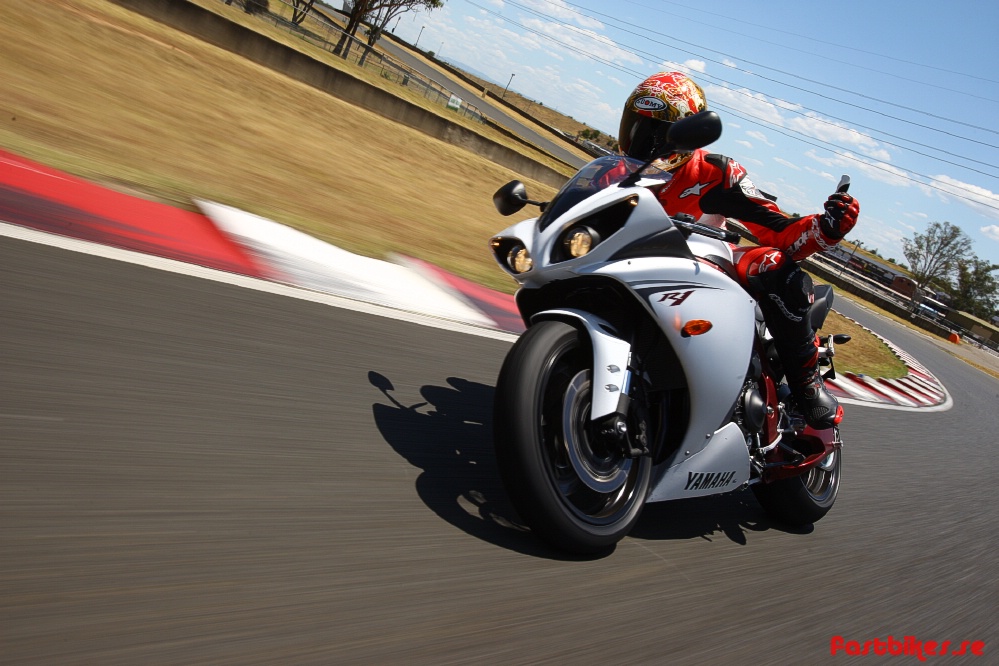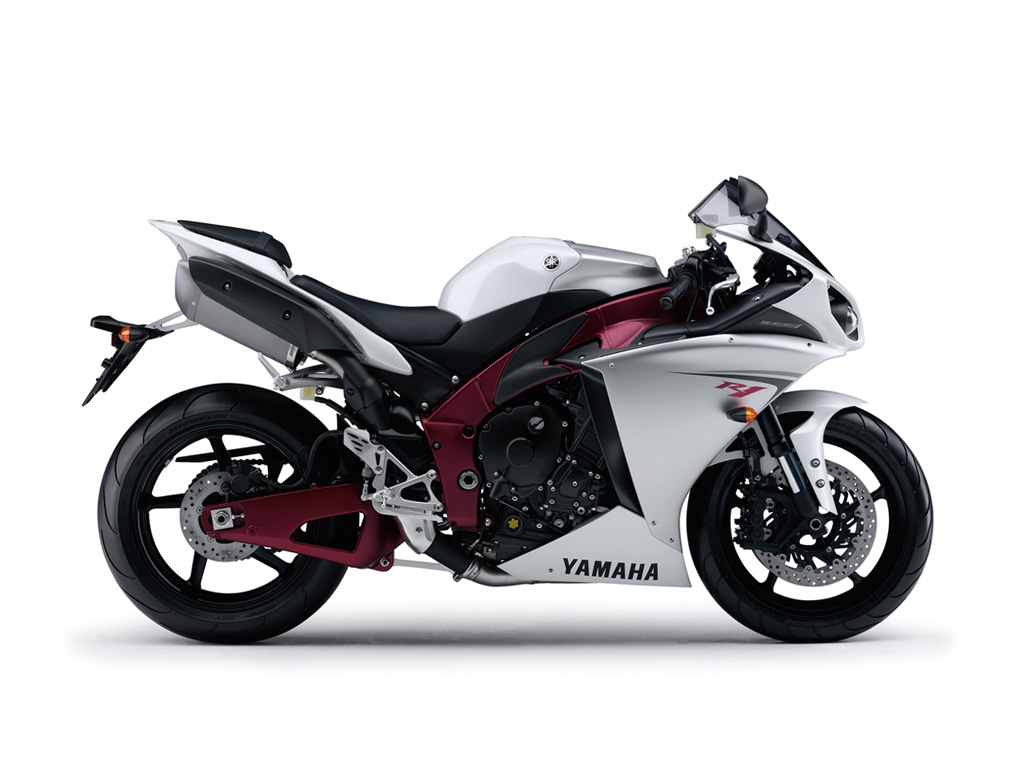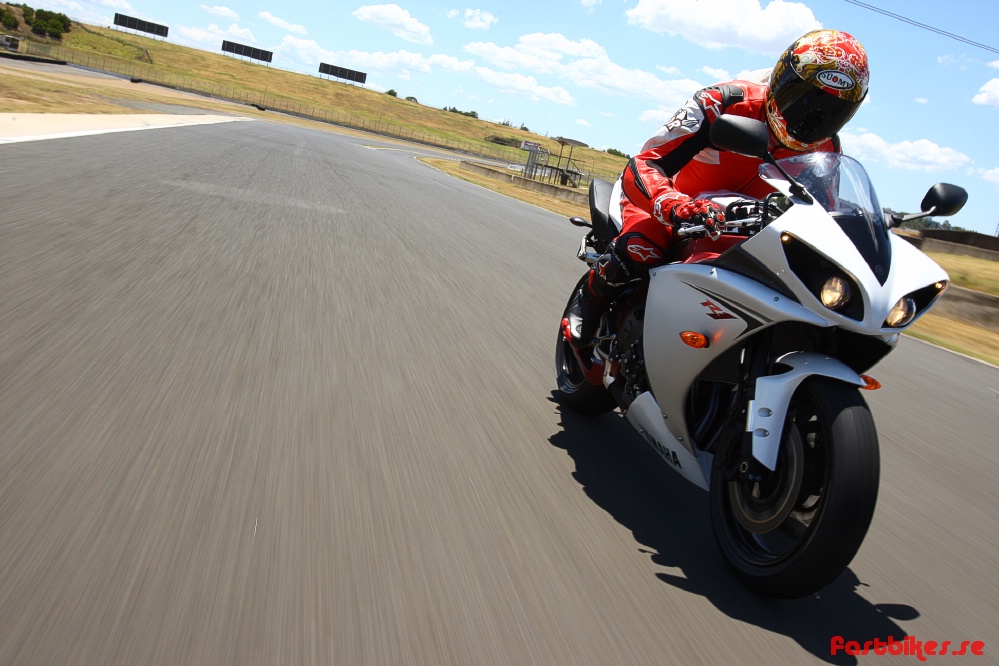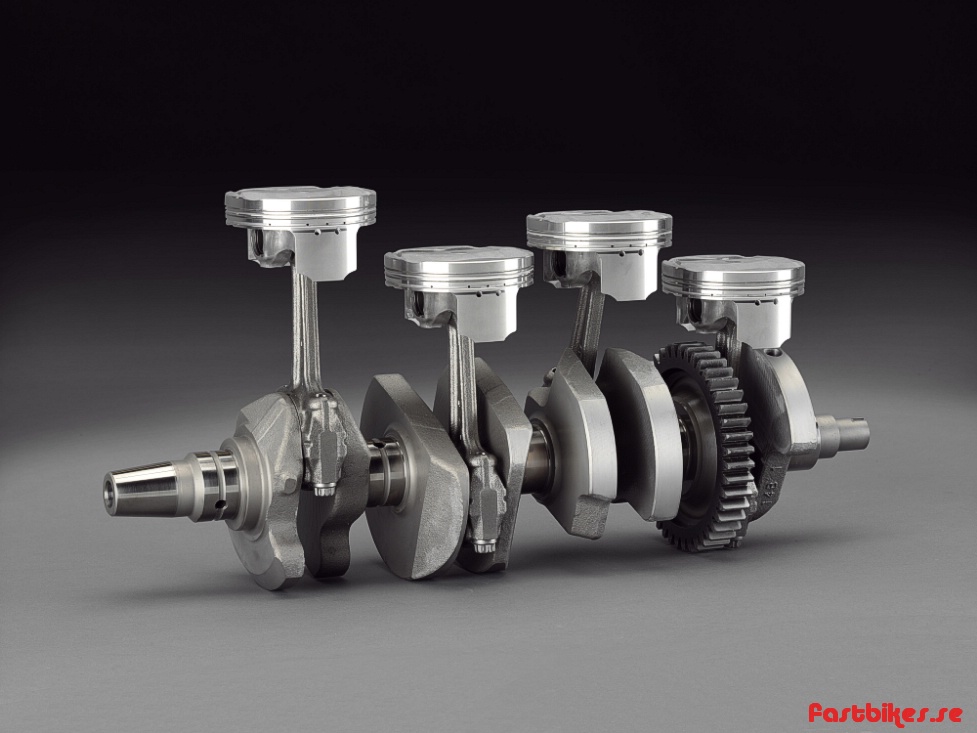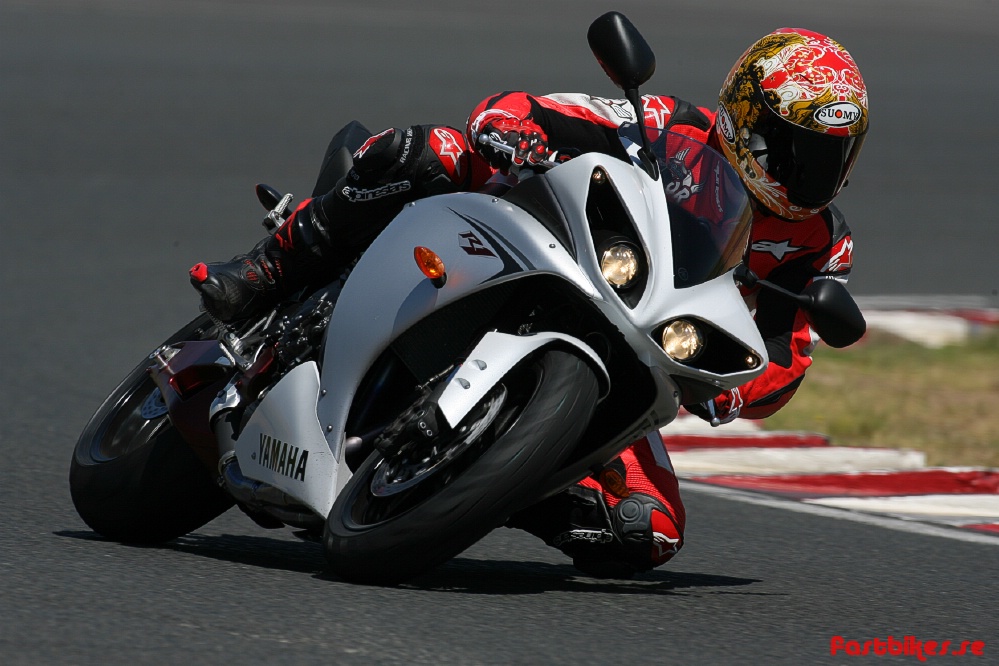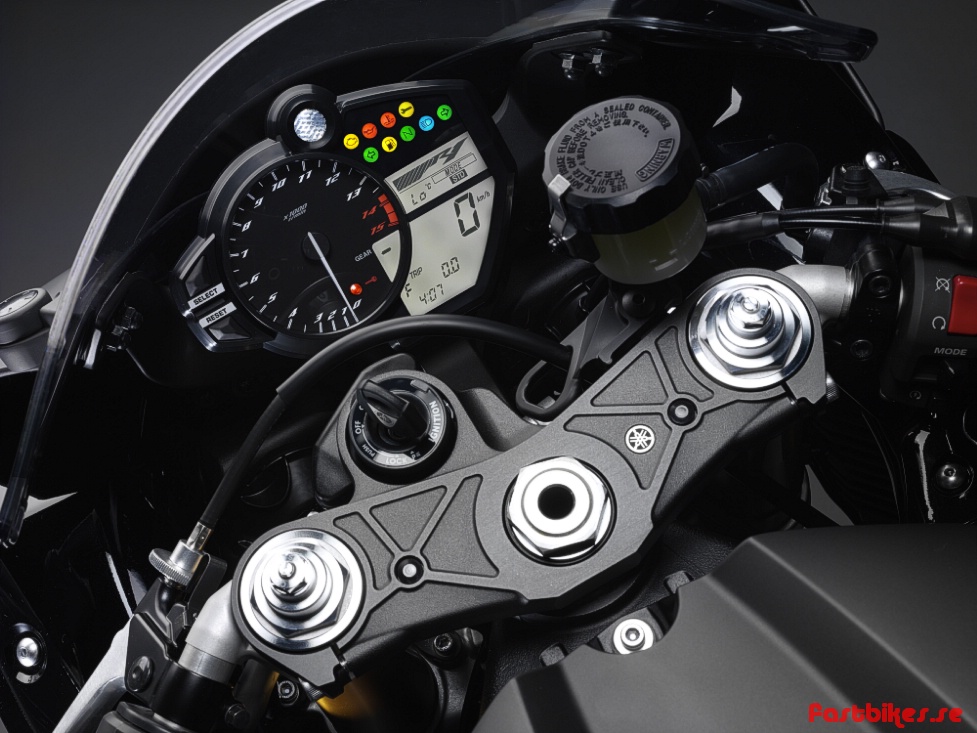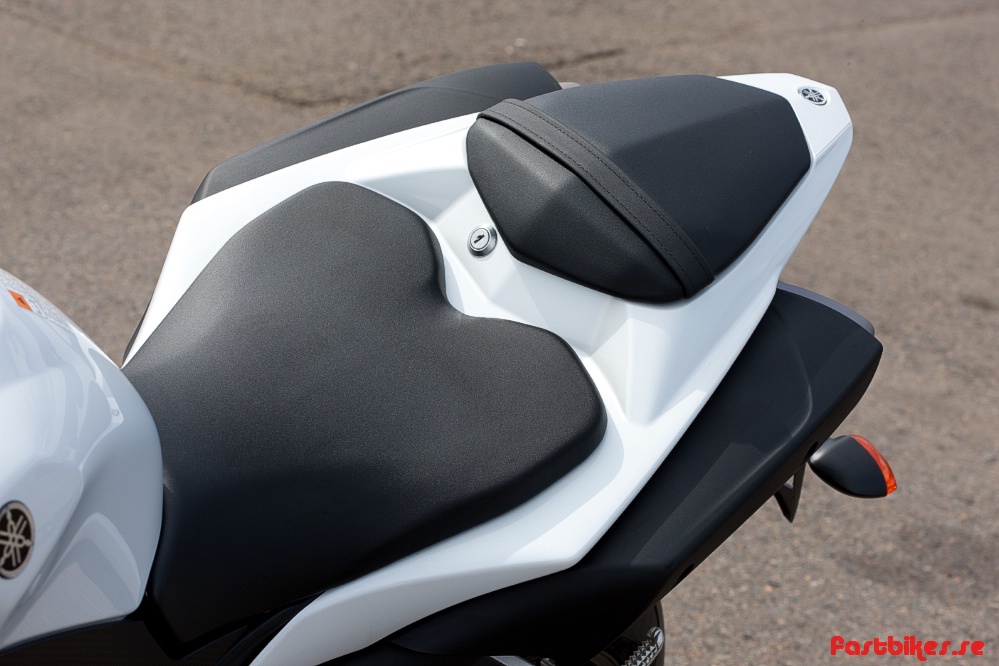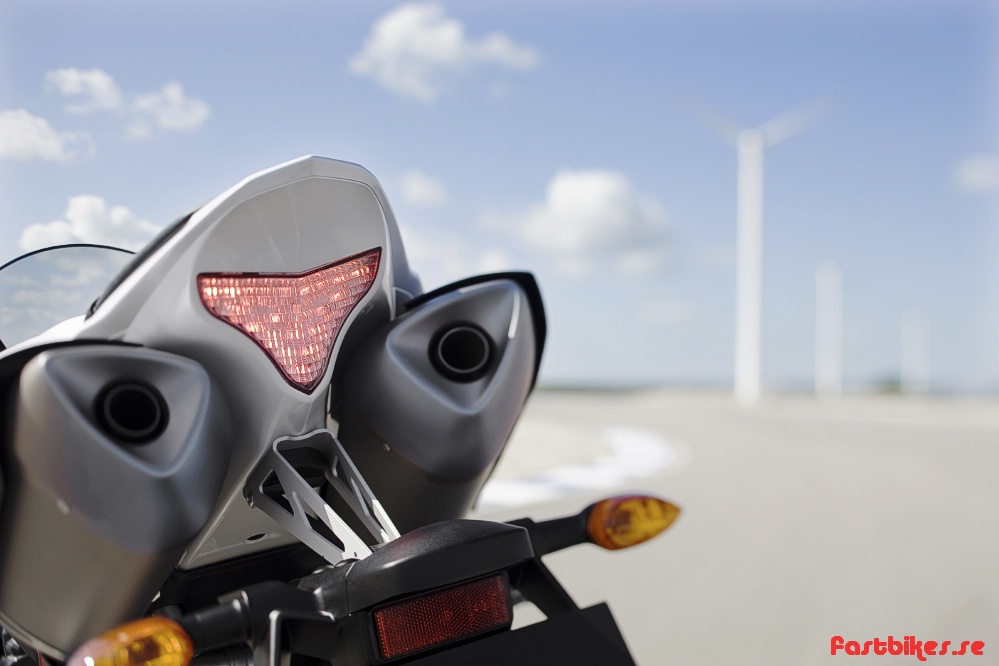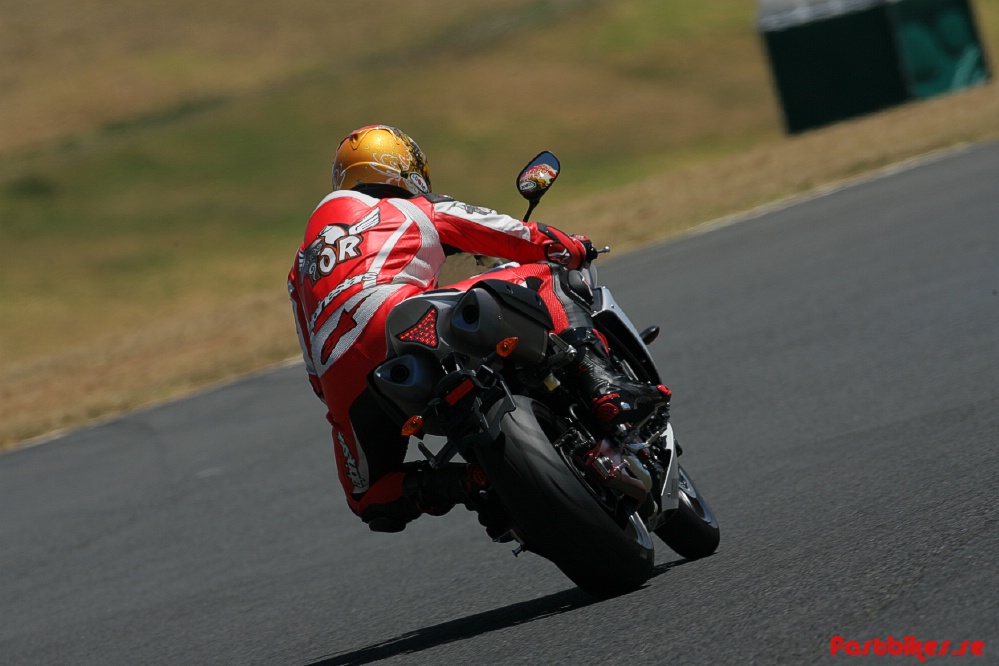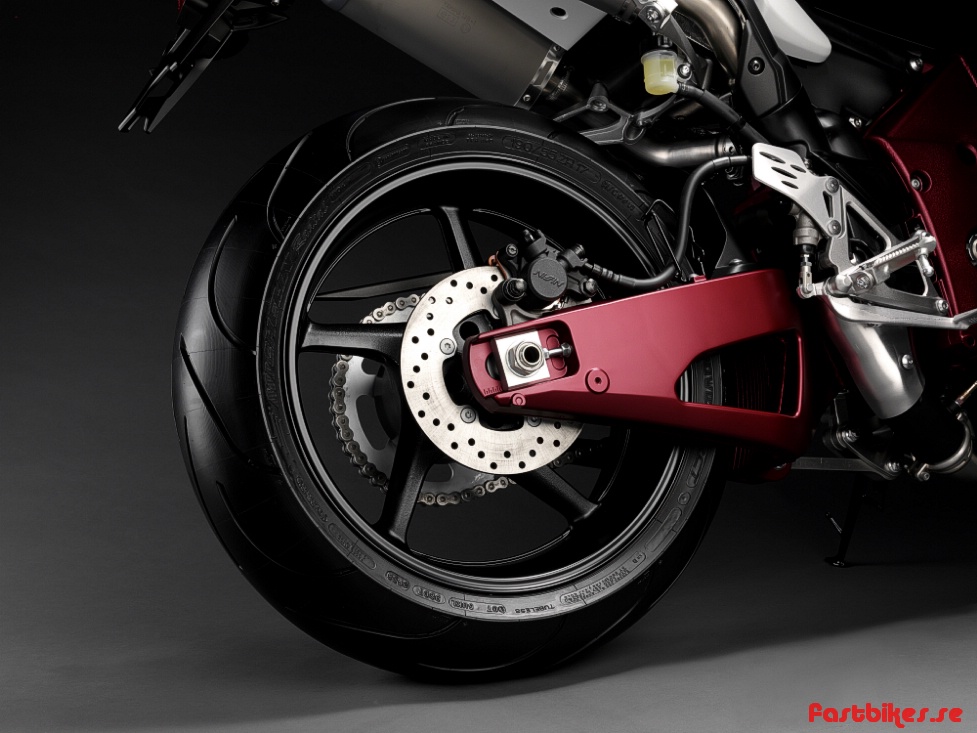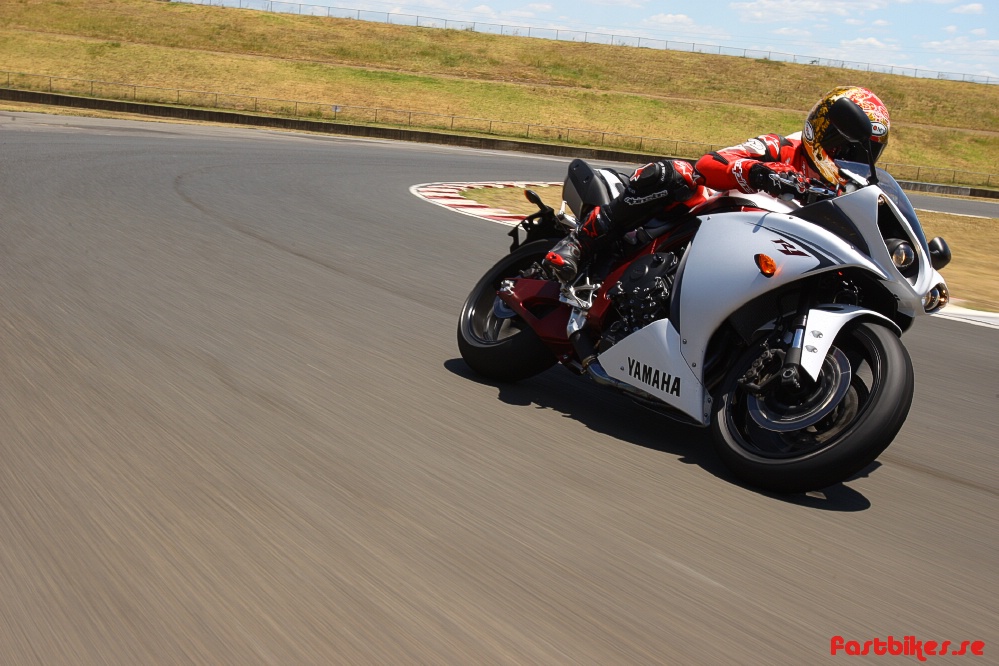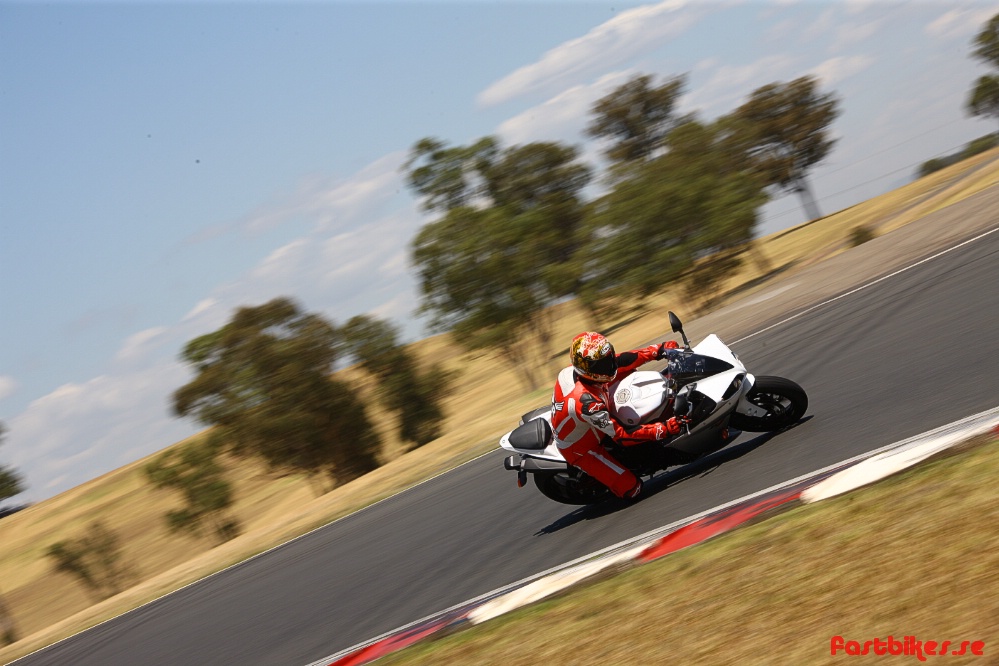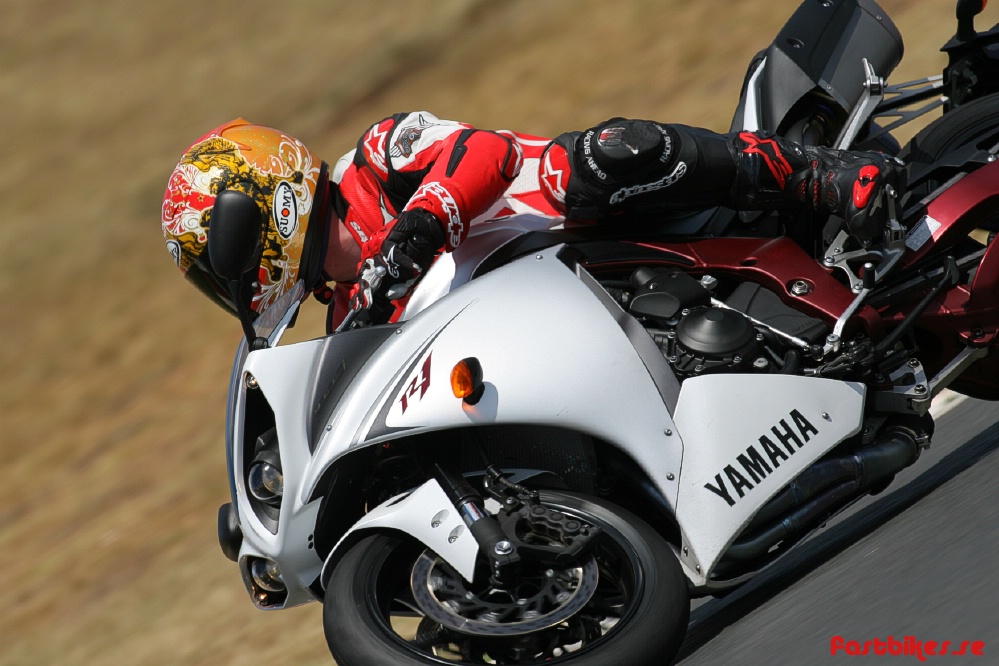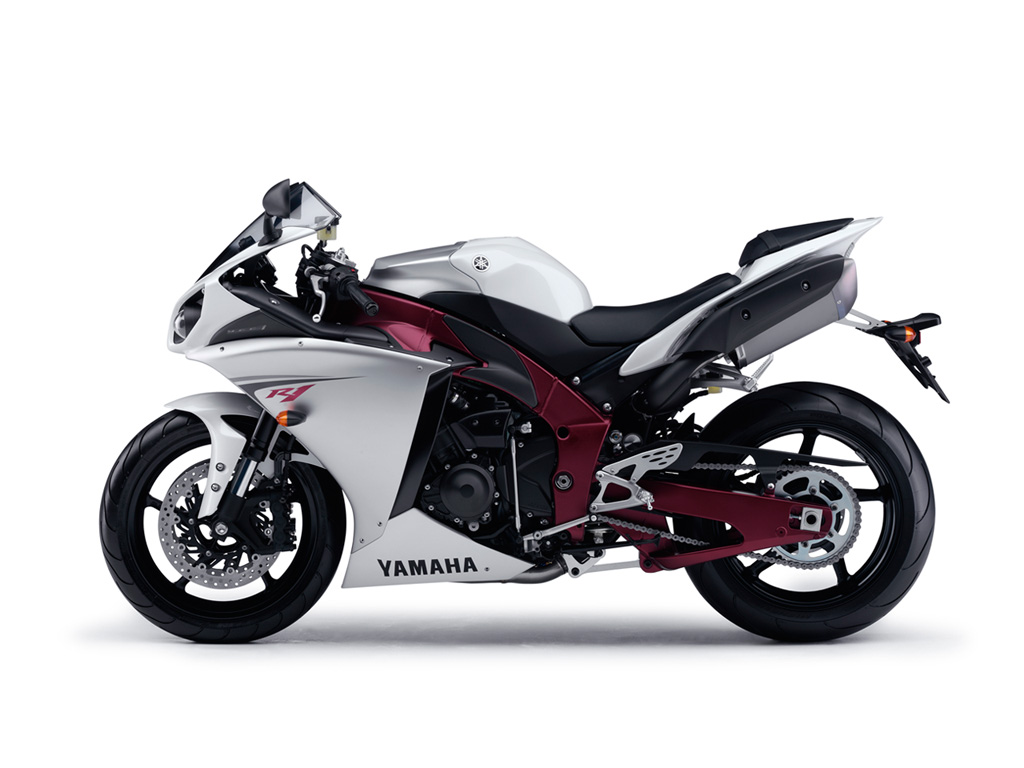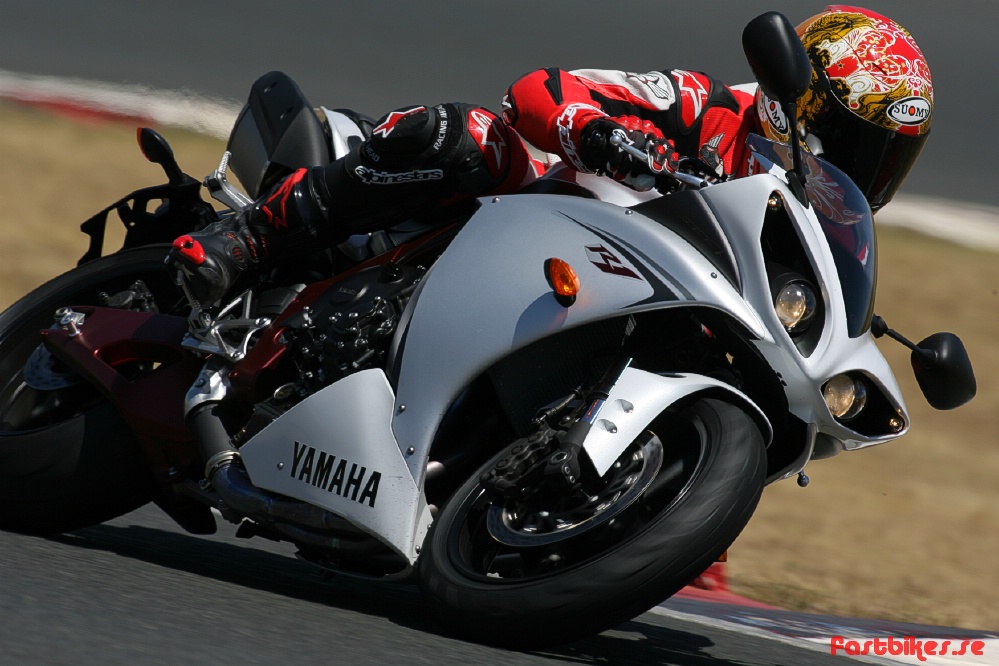Revolutionerande bra!
Yamaha vet onekligen hur en slipsten ska dras. Nya Yamaha YZF-R1 är en revolution på många sätt och vis. Närmare Rossis M1 än så här har vi inte sett en serietillverkad motorcykel vara förr. Nu kan du läsa Sveriges första provkörning av den häftiga sporthojen, direkt från Eastern Creek Raceway i Australien.
Att stå i depån på Eastern Creek Raceway här i Australien och se och lyssna på när 2009 års Yamaha R1 passerar i 250 kilometer i timmen är en underbar upplevelse. Dagarna då toppeffekten var det enda som räknades är förbi. Med få undantag som exempelvis MV:s F4 1078R har jag funderat över hur utvecklingen för radfyrorna ska utvecklas framöver.
180 hästkrafter plus räcker gott och väl, men med så lite karaktär i jämförelse med exempelvis Ducatis sportmotorcyklar, är det lätt hänt att man blir likgiltig till de japanska motorcyklarna. Men det har Yamaha definitivt ändrat på i fallet med nya R1.
Den så kallade Crossplane-teknologin, där en ny vevaxel med oregelbunden tändföljd (270 /180 /90 /180 grader), gör att jag får tillbaka tron på radfyrorna. R1 är så bra att Yamaha garanterat kommer stjäla en hel del marknadsandelar från alla konkurrenterna under 2009.
Äntligen är det min tur och jag startar nya R1 med stora förväntningar. Dessa förväntningar uppfylls med råge redan efter mitt första varv och det är inte ofta sådant händer. Årets Yamaha R1 låter som en riktigt arg hund och matchar hur min hjärna tycker att 182 hästkrafter ska låta som! Vid start är körprogrammet hos R1 sätt till standard.
De andra två inställningarna är A och B. Justeringen av motorkaraktären styrs via det så kallade "fly-by-wire-spjället" i stället för hos motorcykelns elektroniska hjärna, ECU, eller vid tändstiften.
A-läget är den mest aggressiva spjällinställningen och nu stjäl fly-by-wire-spjället ingen effekt. I det här läget kan du utan större problem köra med spinnande bakdäck runt hela Eastern Creek Raceway oavsett om du vill eller inte. Och jag föredrar standardläget vilket jag kör med mestadels eftersom jag inte gillar att köra med B-läget aktiverat på den här banan.
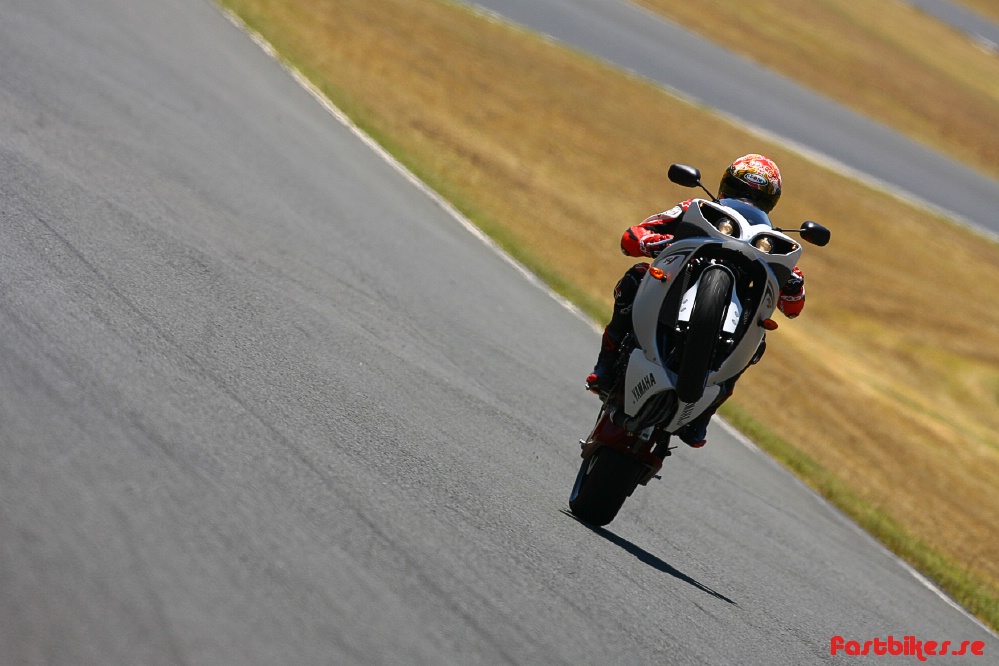
Systemet känner av förändringar hos gasreglaget med god precision och släpper loss helvetet i lagom stora portioner. Fullt i A-läget, optimalt i standardpositionen och begränsat B-läge för exempelvis en regnig dag.
Standarddäcken hos 2009 års Yamaha R1 är den senaste modellen av Pilot Power från Michelin. Nytt är 190/55-ZR17 bakdäck. Vanligtvis har Yamaha valt ett däck med 50-profil bak. Den lite högre profilen hjälper årets Yamaha R1 att svänga ännu kvickare. De främre Michelin Power är med vanlig 120/70-ZR17 dimension. Jag är rädd att dessa däck inte riktigt gillade den brinnande heta banan. Med mer än 40 grader i skuggan är jag ganska säker på att bara däck med riktigt hård gummiblandning skulle kunna lösa vårt lilla värmeproblem.
Senare på dagen fick vi även tillfälla att testa Michelins nya racedäck som också sladdade loss ut ur första och andra böjen, men mycket senare i effektregistret än med Pilot Power-däcken. Och även jag fick antagligen aningen bättre varvtider. Ett motorcykeldäck som kan hantera 182 hästkrafter och en brännhet vägyta så här pass bra får i alla fall tummen upp från mig! Sommartid lär dessa däck erbjuda enormt bra bett på de europeiska banorna.
Efter fem-sex varv i denna värme var det hett som i helvetet inuti skinnstället, men aldrig har helvetet känts så bra vågar jag påstå. Den linjära responsen från den nya Crossplanemotorn gav mig en liknande känsla av trygghet vid extrema nedlägg som Ducatis traditionella sportmotorcyklar brukar göra. Det är svårt att säga exakt vad jag hade förväntat mig trots allt positivt jag hört innan körningen, men nya R1 imponerade i alla fall stort på mig.
Det finns mer chassinyheter i och med den nya flexibla swingarmen som bidrar till ännu bättre kontroll i framförallt kurvorna. Vidare har den nya stötdämparen placerats för bästa viktfördelning och ett nytt länkage av samma modell som hos Rossis M1:a sitter på plats. Den nya positionen har dessutom gjort det möjligt att placera bensintanken lägre vilket centraliserar vikten ytterligare.
Deltaboxramen av aluminium är helt ny och inte mycket är detsamma som hos 2008 års version. Det senaste inom ramtekniken är att använda flera olika komponenter med olika typer av aluminium för att maximera känsla, stabilitet och flexibilitet.
Givetvis är fjädringskomponenterna hos årets R1 fullt justerbara. Nytt är dock det faktum att respektive framgaffelben fyller olika funktioner. Returdämpning regleras av det ena och komprimering av det andra. Mycket smart, och åter ute på banan gör jag så gott jag kan för att pressa komponenterna till det yttersta.
Även motorn har flyttats runt i den nya ramen och framdäcket är i stort sett planterat i backen när jag behöver använda frambromsen. På grund av att den långa huvudrakan på Eastern Creek följs av en höghastighetskurva fick jag aldrig chansen att verkligen testa framgaffeln full ut, men från vad jag upplevde är det här riktigt fasta grejer.
Bromsarna består precis som förra året av dubbla sexkolvs monoblockok fram, men med mindre skivor som bland annat ska förbättra värmeavledningen och bidra till lägre ofjädrad vikt.
Årets R1 känns som något väldigt nytt även vad gäller manöverbarheten. Jag kan enkelt kasta den från vänster till höger precis som om det vore en smidig 600-kubikare. Övergången från hård inbromsning till extrema nedlägg görs på nolltid och med minimal ansträngning.Detta är definitivt något som kommer att vara R1:ans starkaste kort i kommande närkamper med rödlackerade italienare.
Den nya R1 är också mycket mindre wheeliebenägen än jag kan minnas att äldre modeller var, trots den kortare hjulbasen. Och mycket har vi det nya chassiet att tacka för. Vilket leder mig till den del av artikeln där jag vill berätta om hjärtat hos nya R1 och all den smarta teknik som har resulterat i en så extremt bra supersportmotorcykel.
Jag har sparat det bästa till sist och det är den nya radfyran på 998-kubik, som är med den nya vevaxeln alla kommer att tala om framöver. 182 hästkrafter vid 12500 varv kanske inte låter som så mycket av en revolution, men tro mig. Den nya "crossplane" vevaxeln med sin så kallade oregelbundna tändföljd kräver en balansaxel som faktiskt stjäl en del effekt, men fortfarande finns det två fler än hos 2008 års R1:a och framförallt är effektregistret mycket bättre.
Den bör spöa skiten ur 2008 års R1 och jag är säker på att någon kommer att visa att det påståendet stämmer senare i år. Det finns också runt tre newtonmeter mer vridmoment vilket resulterar i 115 newtonmeter vid 10000 varv.
Jag är så glad att kunna säga att dessa siffror inte betyder något alls på ett papper. Du måste provköra den för att verkligen förstå hur stor skillnad den nya vevaxeln gör för att se till att förvandla allt vridmoment till fullt användbar kraft även på högsta varvtal.
Varje gång då jag körde genom kurvorna och varvade motorn 10000 varv (där du har max vridmoment) och mer från mitten av böjen och sedan bara gasade fullt ut ur böjarna var som en dröm. Detta är vad som händer: Cylinder ett tänder vid 270 grader, cylinder två vid 180 grader, cylinder tre vid 90 grader och cylinder fyra vid 180 grader. Detta kallas ojämn tändföljd, vilket i det här fallet ger motorn en karaktär som till viss del påminner om en V-twin. Gasresponsen är städad och jag kan slå på gasen mycket tidigare ut ur böjarna än vad då jag kör en motorcykel med en traditionell radfyra.
En av de stora Bi-produkterna är motorljudet som bäst beskrivs som en blandning mellan en V-fyra och en effektstinn V90. I samband med presentationen hade Yamaha knappast några incidenter alls på banan och det säger en hel del om denna motorcykel. På grund av att värmen gjorde att bakdäcket sladdade mycket körde jag oftast med tvåans växel istället för ettans, men det märks knappt då R1:an drar starkt även från lägre varvtal och det är en sann glädje att vara i sadel på en sådan extrem motorcykel som samtidigt erbjuder den här graden av superkontroll.
Kontroll är nyckeln till framgång här, och årets Yamaha R1 har definitivt den rätta nyckeln. Vid acceleration från tvåans växel på huvudrakan känns 2009 års Yamaha R1 inte lika brutal som årets modell av Ducati 1198S jag testade nyligen, men det kan vara vilseledande eftersom det är lätt att lura sig på den linjära effekten hos R1:an. Jag noterade 260 och 270 på hastighetsmätaren på femmans växel precis innan jag var tvungen att bromsa och växla ner inför den snabba vänsterböjen.•
|
=Wow! Mitt första intryck består. Jag anser att det här är den bästa motorcykel Yamaha någonsin har tillverkat. Och om det är Yamahas bästa är den högt upp på rankinglistan totalt sett också. Enligt min ödmjuka mening finns det bara två motorcyklar i detta segment under 2009 och det är R1 och Ducati 1198.
+ "Crossplane" vevaxeln och motorn, brilliant chassi och manövrering. Bästa motorcykel jag någonsin kört från Yamaha. 2009 års "måste-ha-motorcykel".
|
KLICKA FÖR ATT SE STÖRRE BILDER
{morfeo 27}
FILM FRÅN PROVKÖRNINGEN
{youtube}AjE754X3Owk{/youtube}
Pressrelease på engelska följer nedan (under faktatabell)
|
Fakta Yamaha YZF-R1 -09
|
|
| Motor | Vattenkyld, fyrtakt, 4-cylindrig, 4 ventiler/cyl, DOHC |
| Borr x Slag | 78 x 52,2 mm |
| Slagvolym | 998 cm³ |
| Effekt | 182 hk/12 500 varv |
| Vridmoment | 115,5 Nm/10 000 varv |
| Kompression | 12.7:1 |
| Bränslesystem | Elektronisk bränsleinsprutning |
| Transmission | 6 växlar |
| Hjulbas | 1415 mm |
| Sadelhöjd | 835 mm |
| Fjädring fram | 43 mm inverterad,fullt justerbar |
| Fjädring bak | Fullt justerbar stötdämpare |
| Broms fram |
Dubbla radiellt monterade sexkolvsok, 310 mm skivor |
| Broms bak | Enkolvsok, 220 mm skiva |
| Däck fram | 120/70-17 |
| Däck bak | 190/55-17 |
| Tankvolym | 18 Liter |
| Fulltankad vikt | 206 kg |
| Färg | Svart, blå, vit |
| Pris | 144 900 kronor |
| Importör | |
PRESS RELEASE 2009 YZF-R1 (engelska)
New-generation YZF-R1: Highly purified excitement
The radical and innovative new 2009 model YZF-R1 represents the most significant development in engine and chassis technology ever seen in the 11-year history of this legendary motorcycle.
Since the original YZF-R1 was released into an awe-struck marketplace, Yamaha's flagship 1,000cc model has established a reputation as being one of the most innovative and exciting motorcycles in the large-capacity supersport class. For 2009 that outstanding reputation is sure to be reinforced more than ever before!
Featuring an all-new 998cc engine whose design, feel and character has been influenced by our championship winning M1, the new high-tech R1 powerplant is closely linked to our MotoGP bike. Indeed, in its long and illustrious history, the R1 engine has never benefited from so much MotoGP developed technology as the 2009 model.
In addition, the completely redesigned aluminium Deltabox chassis and aggressive new styling, give the new-generation YZF-R1 a radical new look and bring innovative technology to the class. In the same way that the original YZF-R1 threw the rule book out of the window, this revolutionary new model sets a new benchmark for the super-competitive 1,000cc supersport category.
Crossplane crankshaft engine for purer torque output
Rather than look exclusively to additional electronic aids to further enhance the new YZF-R1's performance and controllability, Yamaha's engineers have opted for a mechanical solution.
The defining and most influential feature of the new YZF-R1 is the use of an innovative new 998cc engine which has been developed from our winning YZR-M1 MotoGP design. Undoubtedly the single most significant piece of technology to be seen on this compact new high-performance engine is its race-developed crossplane crankshaft, which delivers outstandingly pure torque characteristics and high levels of traction. Indeed, the new engine's linear and controllable torque characteristics are the very essence of this radical new generation YZF-R1.
Uneven firing interval for new levels of feel and traction
The new engine's uneven 270° - 180° - 90° - 180° firing interval creates a whole new feel to the inline 4-cylinder engine, giving the new YZF-R1 rider a more precise and immediate feeling of control over the torque output levels. In addition, the new engine's linear torque delivery gives rise to a confidence-inspiring sensation that makes each throttle input, however subtle, feel as though it is transmitted directly to the rear tyre.
The result of this rider-responsive torque is an enormously capable 1,000cc supersport motorcycle that is designed to deliver previously unattainable levels of traction for unrivalled cornering performance.
To accentuate the performance gains of the new crossplane crankshaft engine, we have also developed a new short-wheelbase aluminium Deltabox chassis and optimized the front and rear suspension systems. And the radical and aggressive new styling emphasises the new YZF-R1's concentration of mass and dense compactness.
Engine
Newly-designed inline 4-cylinder engine with crossplane crankshaft
This remarkable new 998cc liquid-cooled inline 4-cylinder 4-valve engine features bore x stroke dimensions of 78.0 mm x 52.2 mm, giving an extremely short stroke layout, together with the largest bore dimensions ever used on a Yamaha 1,000cc supersport engine. In association with the short stroke and big bore, a high compression ratio of 12.7:1 is featured, which contributes to the new engine's impressive power output of 133.9 kW (182 PS) at 12,500 rpm, and a torque output of 115.5 Nm (11.8 kg-m) at 10,000 rpm with natural aspiration.
* In France, in accordance with the enforced regulations, the horsepower is limited. The YZF-R1 provides 78.1 kW (106 PS) at 10,000 rpm and a torque of 90.3 Nm (9.2 kg-m) at 7,000 rpm.
Crossplane crankshaft with uneven firing interval for linear throttle control
Undoubtedly the most significant change for 2009 is the use of an all-new crossplane crankshaft which is based on the advanced race-bred technology that was originally developed for the Yamaha YZR-M1 MotoGP racing machine. This new crossplane crankshaft has been introduced in order to enable the new engine to produce more linear torque characteristics, together with more accurate and linear throttle control.
The new engine's linear power characteristics deliver a 1:1 relationship between the rider's throttle input and the engine's output to the rear tyre, and it is this crucial aspect of the new bike's character that allows the rider to experience a new of level of cornering performance, together with outstanding traction when entering the mid-section of a corner, and also when accelerating out of a bend.
Another feature of the crossplane crankshaft with uneven firing interval is the very special exhaust note that this layout produces, and the new 2009 YZF-R1 engine note has much in common with the YZR-M1 racing machine.
The search for pure torque
When an engine produces torque, it is actually producing what our engineers refer to as "composite torque", which is a combination of the torque produced by combustion, and the inertial torque resulting from the revolution of the engine's crankshaft.
Although the level of combustion torque is both proportionate to, and also a direct result of the rider's throttle input, the inertial torque is produced in direct relation to the changes in inertial force caused by the engine's revolutions - and so this element of the composite torque is not under the direct and immediate control of the rider. The composite torque level varies throughout the engine's rpm range, regardless of the rider's throttle input, and the unpredictable nature of this composite torque means that the rider cannot select precisely and immediately the torque level that they desire at any given moment.
Therefore, in order to be able to offer more linear control to the rider, it is necessary to create an engine where the inertial torque can be minimized, and the composite torque optimized.
Uneven 270º - 180º - 90º - 180º firing interval
One of the most effective means of achieving optimal composite torque in a 4-cylinder engine is the adoption of a crossplane crankshaft with the crankpins positioned to give a firing interval of 270º - 180º - 90º - 180º, as opposed to the 180º - 180º - 180º - 180º firing interval of a conventional 4-cylinder engine.
So, while a conventional 4-cylinder engine sees the four pistons and con rods effectively move up and down in the cylinders as two pairs (i.e. on the 2008 YZF-R1 the two outermost pistons and con rods move together, as do the two innermost pistons and con rods), each piston and con rod in the new crossplane crankshaft has its own individual and separate movement. The result is that the inertial torque created by the reciprocating mass in the new YZF-R1 engine is minimized, while the asymmetric firing sequence achieves a strong pulse at low to mid rpm range, together with excellent linearity across the whole rpm range.
In order to further optimize the combustion forces in the new asymmetric motor, the electronic mapping for the fuel injection system provides separate fuel injection and ignition timing for each cylinder, and this results in highly linear torque characteristics that would not have been achievable on a conventional engine with a standard crankshaft and 180º firing sequence.
And for smoother running the YZF-R1's new engine is also fitted with a primary coupling balancer which reduces the vibration produced by the asymmetric crankpin layout.
Previously the crossplane crankshaft has only been used on competition machinery due to the complex-shaped crankpins and crankshaft parts, as well as other factors including fluctuations in combustion torque pressure and levels of vibration. For these reasons this asymmetric engine layout has never been used before on mass-produced 4-cylinder supersport motorcycles, and its use on the new YZF-R1 represents one of the most significant technical innovations ever witnessed in the 1,000cc supersport category.
Newly-developed forged aluminium pistons
The new YZF-R1 is equipped with lightweight forged aluminium pistons which have been manufactured using the same process as the 2008 YZF-R1. During the special forging process, the aluminium alloy is not actually melted, but is only heated to the temperature where it can be shaped under pressure in the forge. This system allows the aluminium to retain more of the original strength of the metallurgic matrix, which enables our engineers to specify a lighter piston design, thereby reducing reciprocating weight and enhancing throttle response.
Closed-deck ceramic-composite plated cylinder
The new lightweight ceramic-composite plated cylinder provides excellent heat dissipation together with an outstanding rigidity balance. This new short-stroke cylinder features a closed-deck design in which the coolant passages do not pass from the cylinder into the cylinder head, and this makes for high levels of reliability in this type of high compression inline 4-cylinder engine. The new short-stroke engine also benefits from shorter cylinder stud bolts which gives a weight reduction, and at the same time helps reduce overall engine height to give compact overall dimensions.
Fracture split (FS) carburized con rods
The new 2009 model YZF-R1 is equipped with fracture-split (FS) carburized con rods, a system that has been used successfully by Yamaha since the 2004 model YZF-R1. The two halves of each fracture-spit big end ring are re-assembled along the same fracture lines, and this makes for a stronger and more perfectly round big end, giving outstanding performance and reliability.
Optimised large-diameter crank journal and flywheel mass
The all-new YZF-R1 engine design is equipped with a larger 36 mm crank journal (compared to 32 mm diameter on the 2008 model YZF-R1) which is designed to handle the new power and torque characteristics of the crossplane crankshaft.
YCC-I (Yamaha Chip Controlled Intake)
The YCC-I system features electronically-controlled intake funnels whose length can be varied to suit the prevailing engine speed in order to provide good intake pulsation.
At low to mid engine speeds the long and short funnels operate as a single connected unit, but when the engine speed exceeds 9,400 rpm the YCC-I on the new YZF-R1 engine automatically separates the lower funnel and upper funnel by means of an electronically-controlled servomotor. By varying intake length to suit engine rpm, the YCC-I system enables the new YZF-R1 engine to operate more effectively across the rpm band, and the funnel separation process is so smooth that the rider is unaware it has happened.
YCC-T (Yamaha Chip Controlled Throttle)
The advanced YCC-T electronic throttle system delivers outstanding controllability at all speeds, and helps to prevent any hesitation caused by an excessive fuel/air supply when the throttle is opened suddenly. The system adjusts the throttle valve opening via a servomotor at intervals of 1/100th of a second. By constantly calculating and adjusting the optimal throttle opening and intake air volume to match the prevailing engine running conditions, the YCC-T consistently ensures that the new YZF-R1 engine produces an optimum drive torque curve - and the ignition timing is mapped separately for each cylinder in order to ensure efficient combustion processes.
Fuel injection system with secondary injector
The YCC-T operates a highly-efficient twin injector type fuel injection system which is designed to deliver outstanding throttle response and remarkable performance at all riding speeds.
This twin injector system features a main injector together with a secondary injector, which is situated at the upper edge of the funnel. The secondary injector comes into operation in the engine's mid to high-speed range to complement the main injector, and this design ensures remarkable response and outstanding acceleration and performance.
D-mode Map
For the first time on a Yamaha supersport model, the new YZF-R1 is equipped with a D-mode Map which works in association with the YCC-T (Yamaha Chip Controlled Throttle) and allows the rider to select a performance profile to match their requirements.
The D-mode Map consist of three modes which are: Standard mode; A mode; and B mode; and the rider can choose which mode is best suited to the prevailing riding conditions by operating a switch on the handlebars. Standard mode is mapped to give optimum all-round performance, while the A mode delivers sharper engine response, and the B mode gives a gentler response to the rider's throttle inputs.
Redesigned forced air intake
The YZF-R1's redesigned forced air intake system utilises the natural airflow to increase the pressure of the air in the airbox, and this ensures increased levels of power at higher speeds for outstanding performance. This system takes air in through the front cowl, and channels it via the left and right sides of the new frame, directly into the airbox. For 2009 the YZF-R1's forced air intake system incorporates special new side branches which reduce intake noise.
Slipper clutch
For even more stable handling performance when decelerating during quick downshifting, the 2009 YZF-R1 is equipped with a slipper clutch. This clutch features a mechanism that adjusts clutch spring load when excessive torque is transferred from the rear wheel to the crank when the rider changes down through the transmission. By controlling excessive engine braking forces, this system enhances overall controllability.
4-2-1-2 exhaust and twin up-slanted mufflers
In order to ensure an effective exhaust pulsation to complement the new engine's crossplane crankshaft, an all-new exhaust system is fitted, in which the exhaust pipes for the 1st and 4th cylinders and for the 2nd and 3rd cylinders are brought together in a 4-2-1-2 layout.
This high performance system features a 3-way catalyser positioned at the point where the four exhaust pipes meet, and outstanding environmental performance is ensured by an O2 sensor linked to the ECU which constantly adjusts the fuel/air mix in order to minimize harmful emissions.
The stylish triangular-shaped mufflers emit a sharp, gutsy exhaust note which complements the unique pulse created by the asymmetric firing sequence of the new crossplane crankshaft. The triangular design also contributes to the tighter and more compact body design of the all-new YZF-R1, while at the same time giving the bike's rear end a sharp new look.
Engine Technical Highlights
• MotoGP-developed 998cc liquid-cooled inline 4-cylinder 4-valve DOHC
• 133.9 kW (182 PS) at 12,5000 rpm (in France: 78.1 kW (106 PS) at 10,000 rpm)
• 115.5 Nm (11.8 kg-m) at 10,000 rpm (in France: 90.3 Nm (9.2 kg-m) at 7,000 rpm)
• Short-stroke, big-bore design
• Bore x stroke 78.0 mm x 52.2 mm
• Crossplane crankshaft
• Uneven 270º - 180º - 90º - 180º firing interval
• Newly-developed forged aluminium pistons
• Closed-deck ceramic-composite plated cylinder
• Fracture split (FS) carburized con rods
• Optimised large-diameter crank journal and flywheel mass
• YCC-I (Yamaha Chip Controlled Intake)
• YCC-T (Yamaha Chip Controlled Throttle)
• Fuel injection system with secondary injector
• D-mode Map
• Redesigned forced air intake
• Slipper clutch
• 4-2-1-2 exhaust and twin up-slanted mufflers
Chassis
Newly designed aluminium Deltabox frame
The 2009 YZF-R1 runs with a completely new aluminium Deltabox frame which has been designed to deliver class-leading handling and cornering performance. Particular attention has been paid to achieving a handling character which allows the rider to fully utilise the new linear torque characteristics and high levels of traction delivered by the new crossplane crankshaft engine.
With the exception of the internal forced air intake ducts, the newly designed Deltabox frame is virtually completely different to the 2008 design, and as well as featuring a new shape with different dimensions, the type of aluminium used and the frame's overall rigidity balance are also changed for 2009.
The new frame uses a combination of different types of aluminium to achieve the desired balance of rigidity. Gravity cast parts are used for the head pipe as well as the engine mount assemblies and the pivot support assembly, while the outside tank rails are made from CF die-cast aluminium which allows the use of much thinner walls. Parts for the inner tank rail are made from extruded aluminium.
Idealised balance of rigidity
By using a combination of lightweight parts with different characteristics, Yamaha's engineers have succeeded in creating a new Deltabox frame which delivers an idealised balance of rigidity. For 2009, the new YZF-R1's lateral rigidity has been adjusted, and as well as enhancing high speed stability, this feature also helps improve overall handling performance, particularly in terms of enabling effective traction when exiting a curve.
The engine is a stressed member of the frame, and the engine mounts are rigid types, with two on the upper crankcase and two on the lower crankcase, and two at the right and left ends of the cylinder head. The new frame uses extremely strong cast parts at the head pipe, swingarm pivot and engine mounts, while the die-cast and extruded aluminium structures that connect them are given a degree of forgiveness.
This unique combination of rigid and slightly less rigid aluminium components are what give the new YZF-R1's Deltabox frame such a special character, which allows the rider to explore the full potential of the machine's outstanding performance. In addition, the idealised balance of rigidity on this innovative new frame also enhances the very special direct torque feeling associated with the exciting new crossplane crankshaft engine, making the new YZF-R1 a truly unique riding experience.
Compact dimensions with lower centre of gravity
The new R1 engine is mounted 9 degrees more upright than the 2008 model, and the cylinders are angled forward at 31 degrees. Also, the engine mounting position is 12 mm further forward in relation to the drive axis than the 2008 YZF-R1, and this factor helps contribute towards making the front wheel feel even more ‘stuck' to the road. And with the new pivot position set a few mm lower than previously, transfer of drive force to the road surface is improved.
These factors, together with a new fuel tank design, have come together to create a centre of gravity that is slightly lower than the existing model, giving optimized handling performance.
To illustrate the new bike's compactness, an imaginary triangle created by joining the front and rear tyre contact patches with the centre of gravity is smaller than on the 2008 YZF-R1. This compactness makes for agile handling performance, and allows the rider to make full use of the linear torque and high traction when powering out of bends.
New-shape large-capacity fuel tank
Concentration of mass has been a significant feature on all R-series supersport machines, and the new YZF-R1 takes the concept one step further with the fitment of a newly-designed large-capacity fuel tank. The press-formed shape was developed using 3-D simulation analysis technology, and this has enabled our engineers to create a larger, elongated fuel tank which sits neatly within the new twin spar aluminium Deltabox frame.
With a capacity of 18 litres, the shape and position of the new fuel tank helps to improve concentration of mass, and its central location helps to minimize any variation in the new YZF-R1's handling characteristics as the amount of fuel in the tank decreases.
Magnesium rear frame
By using lightweight materials for those components that are furthest from the machine's centre of balance, Yamaha's engineers have been able to enhance the YZF-R1's concentration of mass even further.
The magnesium rear frame made its debut on the 2008 model R6, and its use on the YZF-R1 takes the concentration of mass on this new generation one litre supersport machine to a new level.
New lighter swingarm with optimized rigidity balance
The proven and successful combination of a short wheelbase and long swingarm has been a feature on all YZF-R1 models since the machine was launched. A short wheelbase is associated with high levels of agility and good manoeuvrability, while a long swingarm which pivots close to the machine's mid-way point helps to deliver excellent stability during acceleration. In addition, because the YZF-R1's long swingarm features a pivot point which is located close to the axis of the final drive sprocket, rear suspension squat during hard acceleration is minimized.
For 2009 the swingarm features a gravity-cast pivot assembly, while the arm and end-piece is a single-unit CF die-cast assembly. As a result of these changes, the weight of the new swingarm is reduced, and the rigidity balance has been optimized. This new swingarm design helps to ensure responsive suspension action and enhanced handling performance, especially when the YZF-R1 rider is exiting fast from a corner.
2-way adjustable rear shock absorber and bottom-link rear suspension
The adjustable rear shock absorber is equipped with both low and high-speed compression damping adjustment, allowing the rider to set the machine up to suit their individual needs and different riding conditions.
The new bottom-link type suspension has been developed to make the most effective use of the 120 mm stroke, allowing the shock absorber to function efficiently for a stable and smooth riding experience. Surface feedback and damper response are all improved by the use of a new pillow-type ball joint in the rear shock, and for ease of adjustment, a hydraulic-type adjuster is fitted.
Furthermore, bottom-link system enables to lower the mounting location of the rear suspension, and contributes to concentration of mass by setting the fuel tank in the vacant space.
43mm front forks with independent left/right side damping mechanisms
Like the 2008 model, the new YZF-R1 is equipped with 43mm diameter front forks, but they are of a completely different design to previous suspension systems used on our R-series models.
For 2009 the rebound and compression damping functions are separated, with the left fork equipped with the compression damping valves, and the right fork equipped with the rebound damping valves. This system offers a number of advantages, including the simplification of valve designs and oil flows, as well as minimizing cavitations during successive strokes, and easier adjustment.
Separating the damping functions has also enabled our engineers to increase the diameter of the internal cylinders which helps to stabilize various pressure variances. This increase in cylinder diameter and oil volume also ensures that there is always sufficient oil available to deliver effective damping force for even the smallest front suspension movements. Simpler, more effective and easier to adjust, the new front suspension system offers a clear advantage to the YZF-R1 rider.
Lighter front brake discs with optimized controllability
The R-series models are famous for their class-leading braking performance, and the new YZF-R1's compact system has been designed to offer optimum levels of braking power and controllability. The new front braking system features 310 mm dual discs which are slowed by dual six-piston calipers each containing four pads. The lighter front discs reduce the inertial moment around the axle, which reduces the gyro effect of the front wheel to give lighter, more agile handling and quicker directional changes.
In addition, the inner rotor has been redesigned to give the desired amount of play to promote stable braking force, and a newly designed front brake lever offers improved operability and feel.
The rear brake features a 220mm diameter disc and single-piston pin-slide caliper with an aluminium piston, giving good braking operation and controllability.
Innovative new cooling system with active air management
The cooling system on the new YZF-R1 features a number of innovations, and a unique feature of this advanced new design is the use of lightweight plastic resin piping between the curved radiator and engine. This durable plastic piping has been manufactured using the ‘floating core' method which makes for a lightweight structure, and this is the first time that this weight-saving technology has been used on a production motorcycle*.
By locating the inner cowl as close as possible to the engine, a passage has been created to channel the air after it has passed through the radiator and the two compact fans. At the same time, the negative pressure created along the surface of the middle cowl by the external airflow is actively used to draw this hot air away from the machine, resulting in more effective heat dissipation. Cooling efficiency is further improved by the fact that sufficient space is available between the inner cowl and the engine to allow the heated air to escape with ease.
(*) As of Sept. 2008, based on Yamaha Motor study
Newly-designed rear tyre with 55% R rating
To match the new YZF-R1's increased torque feel and enhanced cornering performance, a new 190/55R-17 rear tyre is fitted. This slightly higher profile tyre (compared to a 50% aspect ratio on the existing YZF-R1) is designed to deliver a good grip feeling especially when accelerating early from a curve.
New-look front end featuring headlights integrated with air intakes
One of the most significant visual changes to the new YZF-R1 is the completely redesigned front cowl which features dual projector headlights integrated with the air induction intakes. At the same time as being instantly recognisable as an R-series design, this radical new front end accentuates the image of the YZF-R1 cutting through the air in forward motion, and gives an even more intimidating and aggressive supersport image.
The innovative new projector headlight design features a solenoid coil type high/low beam switching mechanism, the first time this system has been used on a production motorcycle*. On low beam settings, a shade covers part of the headlight, and when the high beam setting is selected by the rider, the shade retracts to reveal the whole of the projector headlight's beam.
By using this new solenoid coil type high/low beam switching mechanism, Yamaha's designers have been able to replace the 2008 model's four projector headlights (two high beam, two low beam) with two units, allowing much greater freedom in the creation of a much more compact and aggressive front cowl.
(*) As of Sept. 2008, based on Yamaha Motor study
New styling emphasises concentration of mass
The bold new bodywork and aggressive styling is designed to convey the feeling of the new YZF-R1's concentration of mass and dense compactness, together with a sense of minimalism and a front-rear concentration of power.
At the same time the new-look side view is aimed at drawing attention to the visual expression of the immense traction and driving power of the YZF-R1's new crossplane crankshaft engine.
The newly-designed sculptured middle cowl offers excellent aerodynamics for enhanced performance, as well as high levels of wind protection. In addition, this stylish cowl has also been designed to ensure that hot air is removed from the engine compartment, and its other role is to ensure that hot air is extracted from the engine compartment to give excellent heat dissipation.
New for 2009 is the option of a red frame, which is featured exclusively on the white coloured YZF-R1. This white/red colour scheme gives the bike an aggressive look which complements the new bodywork and styling.
New instrumentation
To complement the completely restyled bodywork, new instrumentation is fitted. The new multi-function meter panel features a speedometer, rpm meter, coolant temperature indicator, intake air temperature indicator, two trip meters, trip fuel meter, clock, stopwatch, shift timing light, gear position indicator and engine mode indicator.
Chassis Technical Highlights
• Newly designed aluminium Deltabox frame
• Idealised balance of chassis rigidity
• Compact dimensions and slightly lower centre of gravity
• New-shape large-capacity mass-centralizing fuel tank
• CF die-cast magnesium rear frame
• New lighter swingarm with optimized rigidity balance
• 2-way adjustable rear shock absorber and bottom-link rear suspension
• 43mm front forks with independent left/right side damping mechanisms
• Lighter front discs with optimized controllability
• Innovative new cooling system with active air management
• 190/55-17 rear tyre
• New-look front end featuring headlights integrated with air intakes
• New solenoid coil type projector headlight
• New styling emphasises concentration of mass
• New multi-function instrumentation
Colours
The new YZF-R1 is available in:
1. Competition White with a red frame
2. Yamaha Blue
3. Midnight Black
YEC Racing Parts
Genuine Factory Racing Parts for the YZF-R1
Yamaha Motor Engineering is devoted to the development and manufacture of high-performance engine and chassis racing parts for the Yamaha YZF-R1 and YZF-R6. Yamaha Motor Engineering, which is wholly-owned by Yamaha, is the only officially-approved supplier of racing parts for the R-series machines, offered under the label ‘YEC Racing Parts'.
For 2009 the YEC Racing Parts range includes highly advanced engine and chassis parts which are designed to transform the class-leading YZF-R1 into a full-on race bike which has the potential to win at the very highest level. YEC Racing Parts are used by Yamaha's winning superbike, supersport, superstock and endurance teams, and the very same parts that have helped these teams to numerous successes over the years are now available to the non-factory rider.
Development and manufacturing is fully done in-house, using the experiences and input from our World Superbike and World Supersport teams and our development riders.
All YEC Racing Parts meet Yamaha's rigorous corporate standards, ensuring that with YEC, the customer will only get the highest quality products for their YZF-R1.
www.yamaha-racingparts.com
New YZF-R1. Bred to perfection!
Few other motorcycles can match the heritage of the Yamaha YZF-R1. Launched for the 1998 season, the original YZF-R1 set the supersport world alight with its aggressive looks, broad spread of power, and agile short-wheelbase chassis. Widely regarded as the most significant and influential bike of its time, the original YZF-R1 was, and still is, a masterpiece.
Fast forward 11 years, and Yamaha is about to do it all again with the new-generation YZF-R1. Never before has a production motorcycle been equipped with so much advanced MotoGP-developed technology. From its M1-inspired crossplane crankshaft engine, through to its compact, short-wheelbase Deltabox chassis and stunning new minimalist styling, the 2009 YZF-R1 can justifiably claim to be the most advanced high-performance inline 4-cylinder Yamaha supersport motorcycle ever developed.
With its linear torque output, high levels of controllability and awesome cornering potential, the new-generation YZF-R1 looks sure to secure its position as the world's most remarkable 1,000cc supersport motorcycle.


